CocoIndex + Kuzu: Real-time knowledge graph with Kuzu
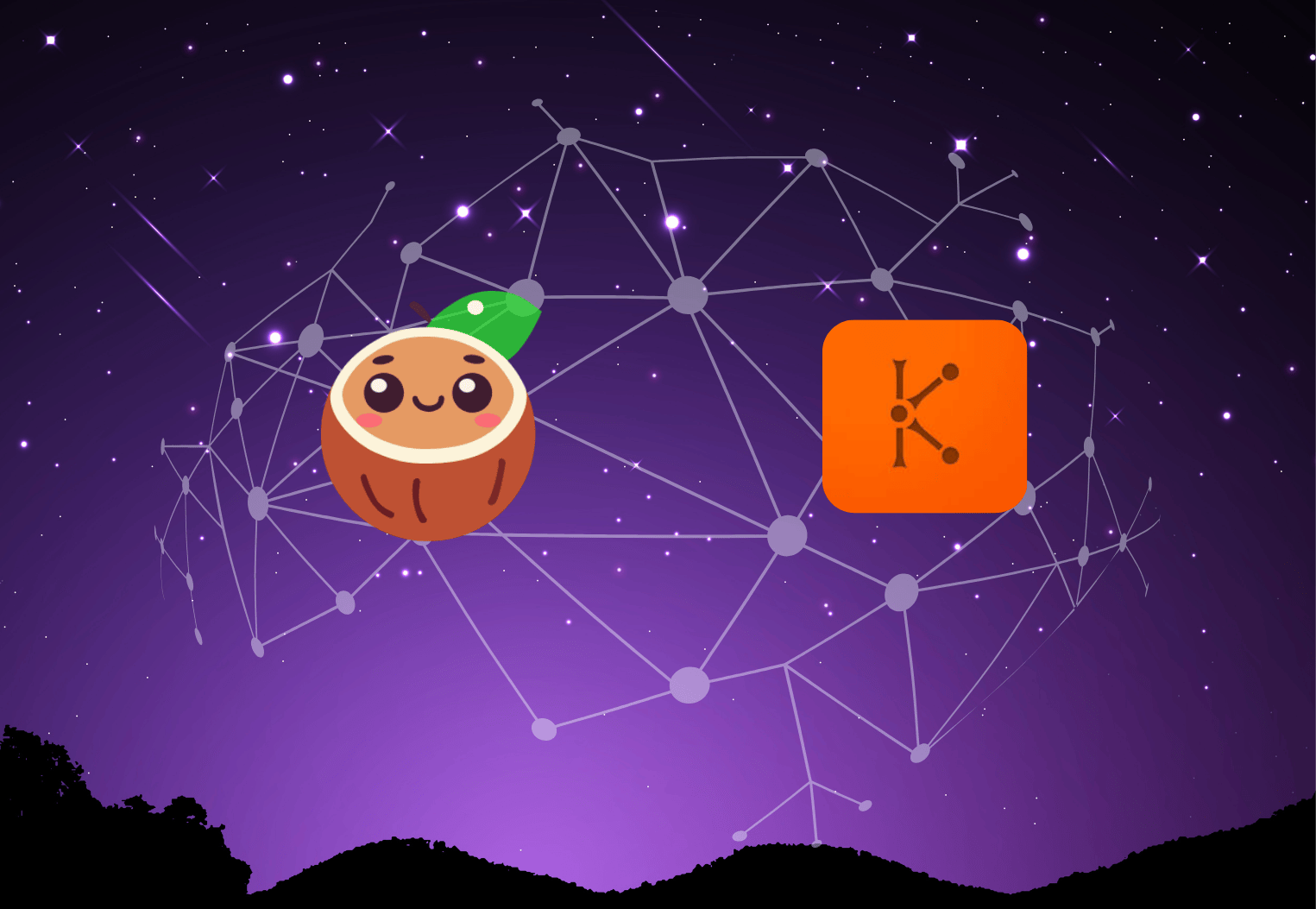
CocoIndex now provides native support for Kuzu as a target graph data store. This integration features a high performance knowledge graph stack with real-time updates.
What is Kuzu
Kuzu is a graph database that is designed to be fast, scalable, and easy to use. We love Kuzu because it is high performant, lightweight, and open source.
Kuzu has been officially archived as per their announcement.
CocoIndex is an ultra performant real-time data transformation framework, with dataflow programming model, CocoIndex simplifies building and maintaining knowledge graphs with continuous source updates. You can read the official CocoIndex Documentation for Property Graph Targets here.
We understand preparing data is highly use-case based and there is no one-size-fits-all solution. We take the composition approach. Instead of you building everything, we provide tons of native building blocks. By standardizing the interface, we make it easier to plug in and play with 1-line code switch, as simple as assembling the building blocks.
If you are using CocoIndex to build your knowledge graph, you can use Kuzu as a target graph data store.
How to map to Kuzu in CocoIndex
The GraphDB interface in CocoIndex is standardized, if you are already using Neo4j, you just need to switch the configuration to export to Kuzu as below. CocoIndex supports exporting to Kuzu through its API server. You can bring up a Kuzu API server locally by running:
KUZU_DB_DIR=$HOME/.kuzudb
KUZU_PORT=8123
docker run -d --name kuzu -p ${KUZU_PORT}:8000 -v ${KUZU_DB_DIR}:/database kuzudb/api-server:latest
In your CocoIndex flow, you need to add the Kuzu connection spec to your flow.
kuzu_conn_spec = cocoindex.add_auth_entry(
"KuzuConnection",
cocoindex.storages.KuzuConnection(
api_server_url="http://localhost:8123",
),
)
What does it look like to build an indexing flow with CocoIndex + Kuzu
A CocoIndex knowledge graph example that got the most love is to build knowledge graph with LLM, here is a detailed step-by-step blog. In the project, we process a list of documents,and use LLM to extract relationships between the concepts in each document.
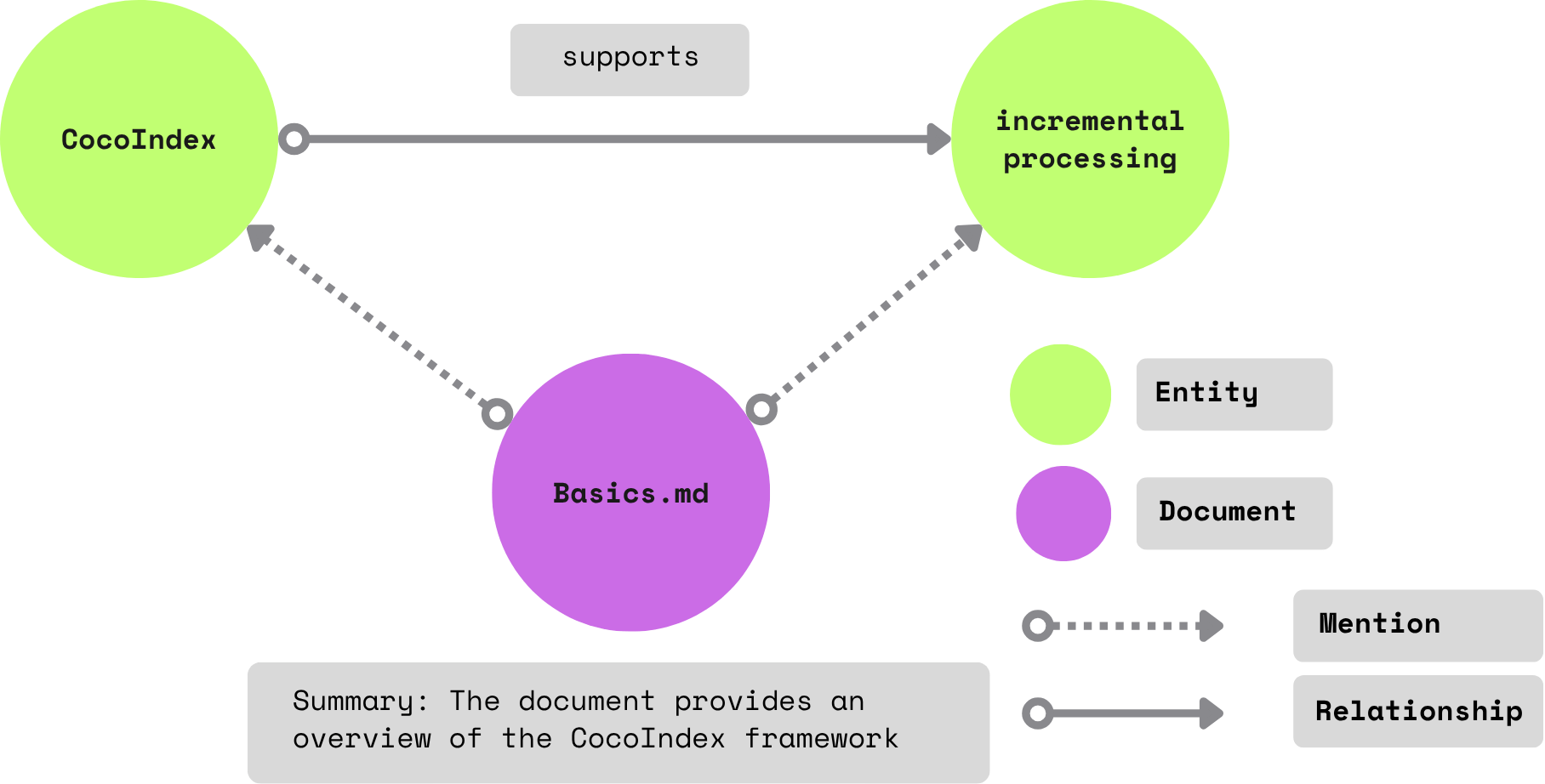
We will generate two kinds of relationships from the documents:
- Relationships between subjects and objects. E.g., "CocoIndex supports Incremental Processing"
- Mentions of entities in a document. E.g., "core/basics.mdx" mentions CocoIndex and Incremental Processing.
The indexing flow looks like this for Kuzu:
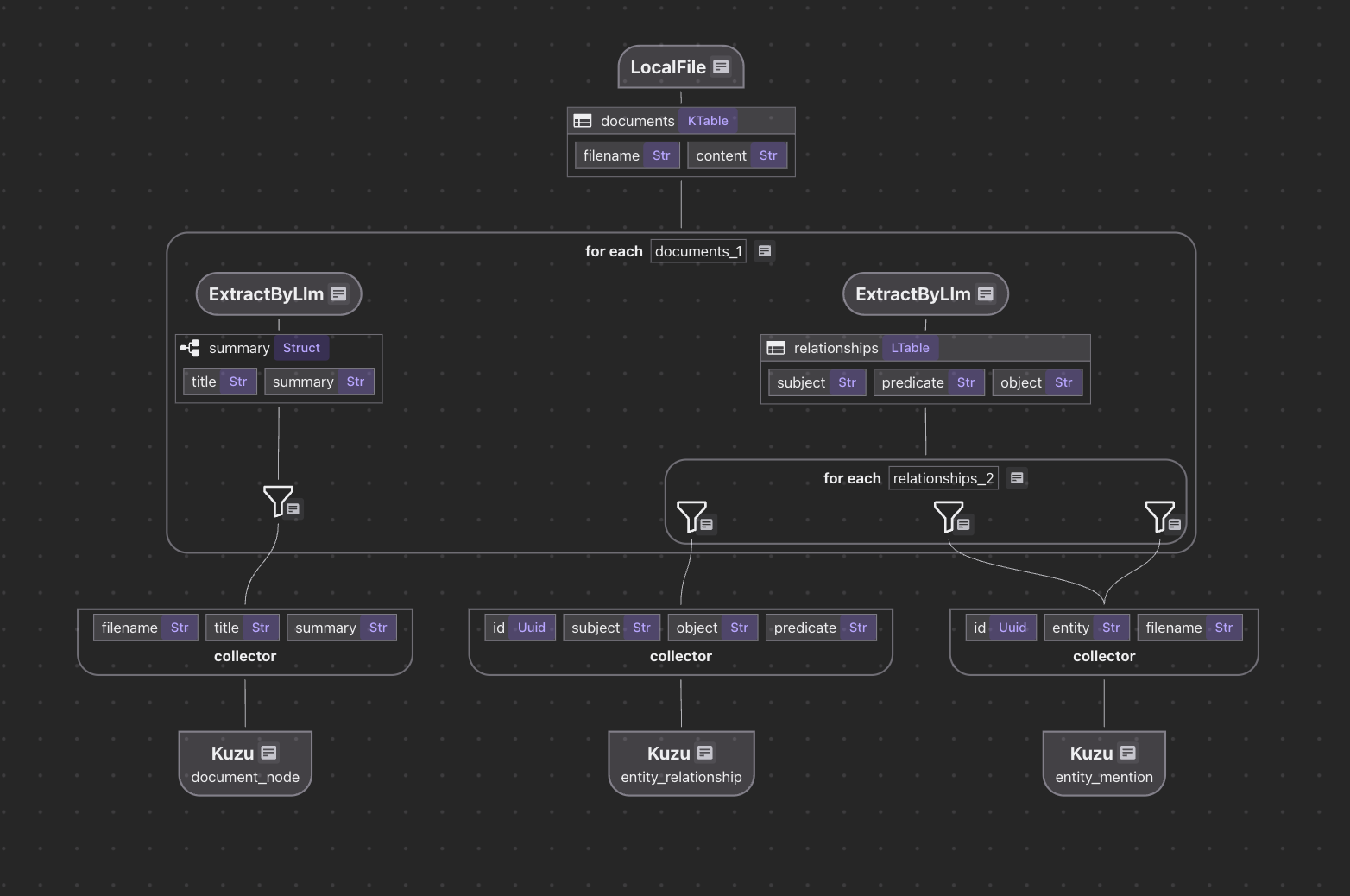
The code is available here.
- Ingest the documents into CocoIndex
- Process the documents, for each document:
- Map document nodes: Use LLM to generate summary, and map the documents to Graph nodes in Kuzu.
- Map relationship nodes: Use LLM to extract relationships, and export the relationships to Kuzu.
Notably, it only takes ~200 lines of python to have a production ready knowledge graph; including class definitions, prompts, and configs.
To highlight how the relationship extraction works, you will define a python class for structured extraction.
@dataclasses.dataclass
class Relationship:
"""
Describe a relationship between two entities.
Subject and object should be Core CocoIndex concepts only, should be nouns. For example, `CocoIndex`, `Incremental Processing`, `ETL`, `Data` etc.
"""
subject: str
predicate: str
object: str
If you have a predefined set of ontology, you can skip the entity extraction use existing entities.
Call a transformation in the flow to extract the relationships from the document.
with data_scope["documents"].row() as doc:
# extract relationships from document
doc["relationships"] = doc["content"].transform(
cocoindex.functions.ExtractByLlm(
llm_spec=cocoindex.LlmSpec(
# Supported LLM: https://cocoindex.io/docs/ai/llm
api_type=cocoindex.LlmApiType.OPENAI,
model="gpt-4o",
),
output_type=list[Relationship],
instruction=(
"Please extract relationships from CocoIndex documents. "
"Focus on concepts and ignore examples and code. "
),
)
)
You could use CocoInsight to verify each pair of the relationships.
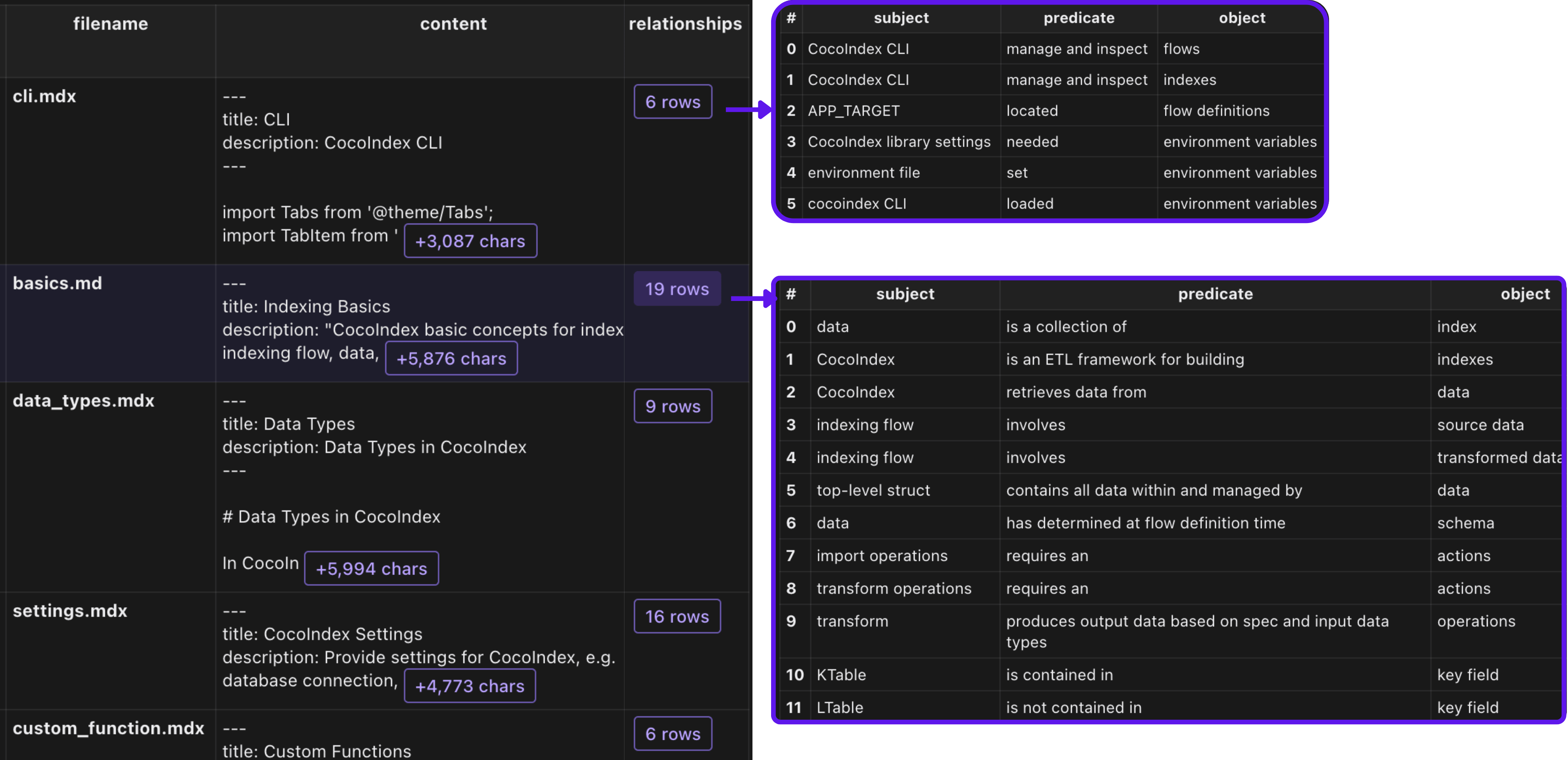
and then collect the relationship use entity_relationship collector.
with doc["relationships"].row() as relationship:
# relationship between two entities
entity_relationship.collect(
id=cocoindex.GeneratedField.UUID,
subject=relationship["subject"],
object=relationship["object"],
predicate=relationship["predicate"],
)
CocoIndex follows a dataflow programming model. Rather than defining data operations like creations, updates or deletions, developers only need to focus on transformations or formulas based on source data. The framework takes care of the data operations such as when to create, update, or delete.
Once you have collected the relationships, you can directly map it to Kuzu as below.
entity_relationship.export(
"entity_relationship",
cocoindex.storages.Kuzu(
connection=conn_spec,
mapping=cocoindex.storages.Relationships(
rel_type="RELATIONSHIP",
source=cocoindex.storages.NodeFromFields(
label="Entity",
fields=[
cocoindex.storages.TargetFieldMapping(
source="subject", target="value"
),
],
),
target=cocoindex.storages.NodeFromFields(
label="Entity",
fields=[
cocoindex.storages.TargetFieldMapping(
source="object", target="value"
),
],
),
),
),
primary_key_fields=["id"],
)
Amazingly, while working on this Kuzu example, I had a previous flow that I ran locally with Neo4j. It was instant to export to Kuzu. CocoIndex is based on incremental processing, and if you have already run this flow before and just switched targets, the intermediate transformation results can be reused.
To run the Kuzu Explorer - an open source UI for Kuzu, you need to first bring down the Kuzu API server.
And then you can run the following command to start the Kuzu Explorer:
KUZU_EXPLORER_PORT=8124
docker run -d --name kuzu-explorer -p ${KUZU_EXPLORER_PORT}:8000 -v ${KUZU_DB_DIR}:/database -e MODE=READ_ONLY kuzudb/explorer:latest
We could then access the explorer at http://localhost:8124. We could run a Cypher query to explore the graph.
MATCH p=()-->() RETURN p
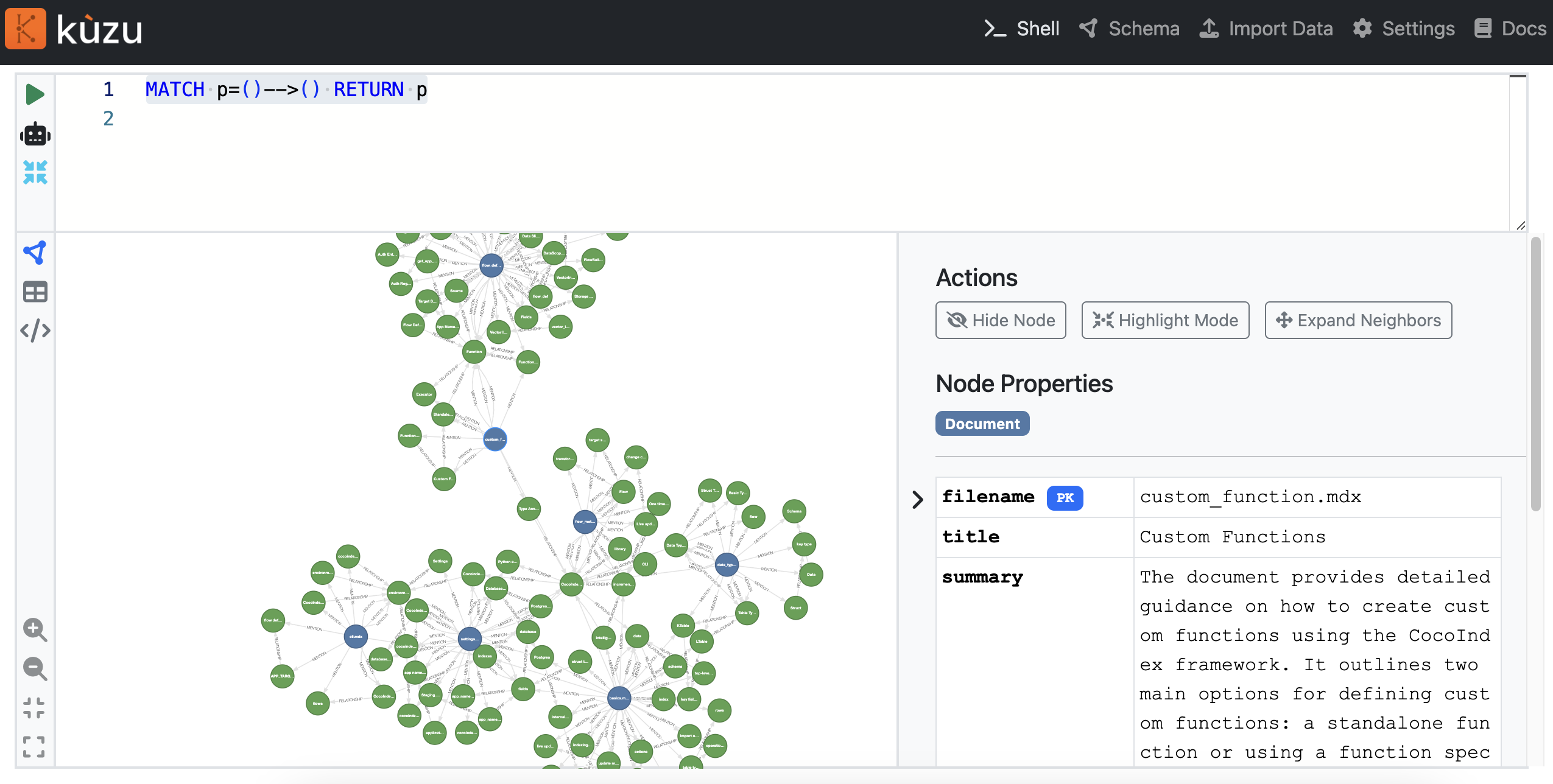
Support us
We are constantly improving, and more features and examples are coming soon. If this article is helpful, please drop us a star ⭐ at GitHub to help us grow.
Thanks for reading!
